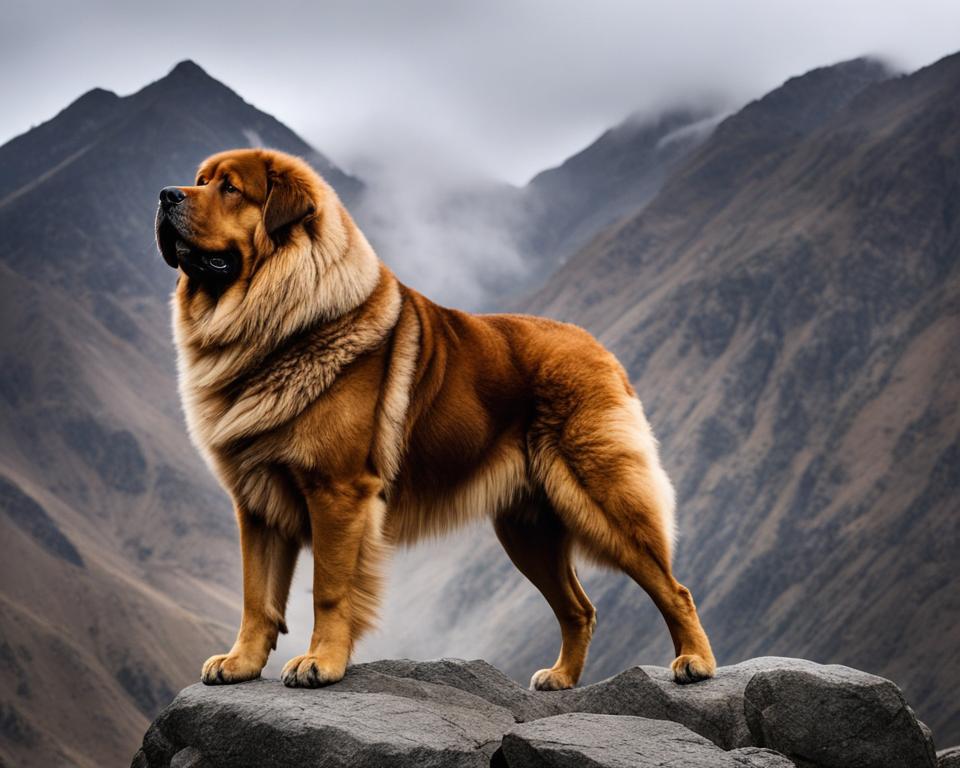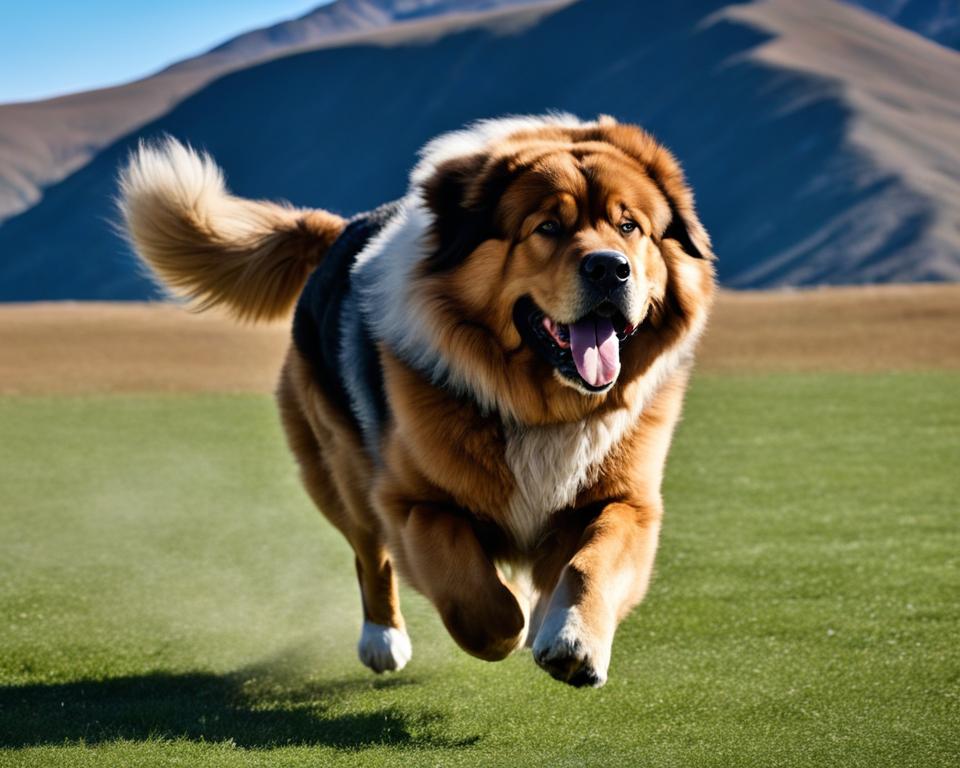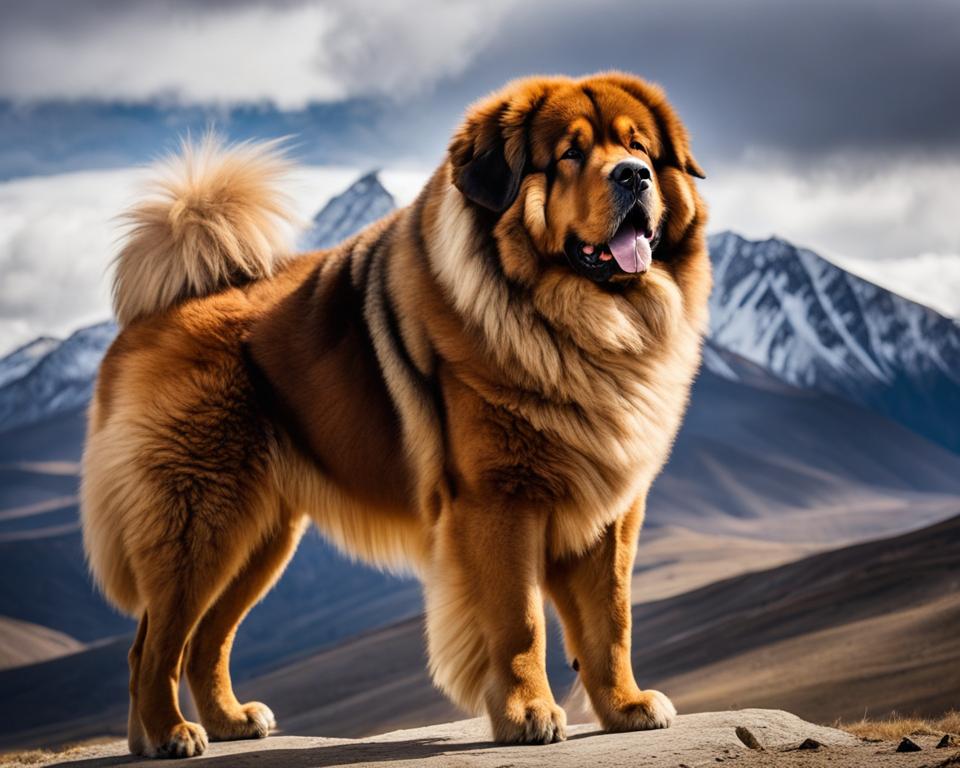The Tibetan Mastiff is an ancient breed known for its loyal and protective nature. With a history spanning thousands of years, these majestic dogs have been guarding and protecting their owners with unwavering devotion.
Tibetan Mastiffs are intelligent and independent, forming strong bonds with the people they care about. Despite their imposing size and thick double coat, they are not high-energy dogs and can adapt well to family life. However, their independent streak requires patient and consistent training.
When it comes to their temperament, Tibetan Mastiffs possess a calm and steady disposition. They are naturally wary of strangers, making them excellent guard dogs. But with proper socialization, they can also be friendly and well-behaved around new people and other animals.
If you are considering adding a Tibetan Mastiff to your family, it’s important to understand their unique characteristics and traits. Let’s delve deeper into the fascinating world of Tibetan Mastiffs and uncover what you can expect when living with this magnificent breed.
Key Takeaways:
- Tibetan Mastiffs are loyal and protective, making them great companions and guard dogs.
- They have an independent nature that requires patient training and consistent guidance.
- Tibetan Mastiffs have a calm and steady temperament, but proper socialization is necessary.
- They thrive in a loving and dedicated family environment.
- Regular grooming is essential to maintain their thick double coat.
History and Origins of the Tibetan Mastiff
The Tibetan Mastiff is an ancient breed with a rich history dating back thousands of years. This majestic dog originated in Tibet, where evidence suggests the presence of a mastiff-like breed as early as 5,000 years ago. Although there is limited information available about the breed prior to the 19th century, Tibetan Mastiffs gained attention in the Western world when they were presented as gifts to English royalty in 1847.
The Tibetan Mastiff’s impressive size and distinctive qualities made them sought after as guard dogs. They were particularly valued for their deep and loud bark, which served as a deterrent to potential intruders. This breed played a crucial role in protecting livestock and properties in the Himalayan region, where harsh weather conditions and rugged terrain demanded a vigilant and resilient guardian.
Ancient Breed and Cultural Significance
The Tibetan Mastiff holds great cultural significance in Tibet, where it was revered as a symbol of status and wealth. These dogs were highly regarded within Tibetan communities and often provided protection to monasteries, nomadic encampments, and even Tibetan royalty. Their imposing presence and unwavering devotion made them the breed of choice for those in need of a reliable and fearless guardian.
Known for its ability to adapt to the harsh environment of the Tibetan Plateau, the Tibetan Mastiff developed remarkable survival skills, endurance, and resilience. Its thick double coat, sturdy build, and strong physique allowed it to thrive in extreme temperatures and challenging terrains, further solidifying its place as an invaluable companion and protector.
The centuries-old history of the Tibetan Mastiff is a testament to its exceptional qualities and its enduring legacy as an ancient breed with a profound connection to the people and culture of Tibet.
Physical Characteristics of the Tibetan Mastiff
The Tibetan Mastiff is a majestic and impressively large dog breed known for its powerful build and distinctive appearance. Let’s delve into the physical attributes that make this breed truly remarkable.
Size and Weight
The Tibetan Mastiff is a giant breed, with males typically ranging in height from 26 to 30 inches and weighing between 100 and 160 pounds. Females are slightly smaller, standing at 24 to 28 inches tall and weighing between 75 and 120 pounds. This size and weight give the Tibetan Mastiff an imposing presence and make them an ideal choice for a protective guardian.
Coat
The Tibetan Mastiff boasts a luxurious and weather-resistant dense double coat that helps them thrive in harsh mountain climates. Their outer coat is long, straight, and coarse, while the undercoat is soft and insulating. This combination provides them with excellent protection against extreme temperatures. The coat requires regular maintenance to keep it healthy and tangle-free.
| Coat Colors | Description |
|---|---|
| Black | A solid black color that gives the dog a striking and imposing appearance. |
| Brown | Ranging from light to dark shades, brown coats bring warmth and elegance. |
| Gray | Varied shades of gray, from light silver to deep charcoal, add a touch of sophistication. |
| Gold | A stunning gold coat that radiates beauty and grace. |
These magnificent creatures captivate with their enormous size, extraordinary strength, and captivating coat. In the next section, we will explore the unique temperament traits that define the Tibetan Mastiff.
Temperament Traits of the Tibetan Mastiff
The Tibetan Mastiff is a breed known for its protective instincts, loyalty, and independent nature. These temperament traits make them unique and highly valued among dog owners.
Protective Instincts
Tibetan Mastiffs have a strong sense of protection towards their family members and territory. With their imposing size and powerful presence, they make excellent guard dogs. Their protective instincts are deeply ingrained and can be seen in their unwavering loyalty and readiness to defend their loved ones. This instinctive nature is one of the essential characteristics of the breed.
Loyalty
The loyalty of the Tibetan Mastiff is unmatched. They form strong bonds with their owners and are intensely devoted to them. Whether it’s a single person or an entire family, the Tibetan Mastiff will always prioritize their loved ones’ safety and well-being. This unwavering loyalty creates a deep companionship and trust that is cherished by those who have the privilege of sharing their lives with these magnificent dogs.
Independent Nature
The independent nature of the Tibetan Mastiff can present both challenges and rewards. Their independence makes training more challenging compared to other breeds, as they have a strong will and a natural inclination to make decisions for themselves. However, this independent nature also contributes to their self-assured and confident demeanor, as well as their ability to think and act independently in different situations. It’s important for owners to approach training with patience, consistency, and positive reinforcement methods to establish a balanced and respectful relationship with their Tibetan Mastiff.
Despite their calm and steady temperament, Tibetan Mastiffs are not known for being overly energetic or hyperactive. They are generally relaxed and composed dogs, which can make them an excellent fit for individuals or families seeking a calm and peaceful companion.

| Temperament Traits | Description |
|---|---|
| Protective Instincts | Tibetan Mastiffs are known for their strong protective instincts. They are dedicated to keeping their family and territory safe. |
| Loyalty | Tibetan Mastiffs are incredibly loyal to their owners. They form strong bonds and prioritize the well-being of their loved ones. |
| Independent Nature | Tibetan Mastiffs have an independent and self-assured nature. They can think and act independently, but training requires patience and consistency. |
Living with a Tibetan Mastiff: Training and Exercise
Training a Tibetan Mastiff can be a rewarding experience, but it requires patience and consistency. Due to their independent nature, positive reinforcement methods work best with this breed. They respond well to firm and gentle guidance, allowing their intelligence to shine through.
Tibetan Mastiffs require daily exercise to keep them healthy and content. While they’re not as high-energy as other breeds their size, they still enjoy moderate walks and playtime. Providing them with mental stimulation is equally important. Interactive toys and training sessions can help keep their minds sharp and prevent boredom and destructive behavior.
| Training Tips for Tibetan Mastiffs | Exercise Needs |
|---|---|
|
|
By incorporating regular exercise and mental enrichment into their routine, you can ensure that your Tibetan Mastiff stays happy, healthy, and well-behaved. The combination of physical and mental stimulation is key to meeting their exercise needs and harnessing their independent nature.

Tibetan Mastiff as a Family Pet
Tibetan Mastiffs can make wonderful family pets. They are loyal, protective, and loving towards their families. They are generally good with children, but early socialization is important to ensure they are comfortable and well-behaved around kids. Tibetan Mastiffs thrive when they are included in family activities and given plenty of attention and affection. It’s essential to establish leadership and boundaries with this breed to prevent any potential behavior issues.
The Benefits of Having a Tibetan Mastiff as a Family Pet
- Loyalty: Tibetan Mastiffs are fiercely loyal to their families. They will go to great lengths to protect their loved ones, making them excellent guard dogs.
- Protective Nature: With their protective instincts, Tibetan Mastiffs provide an added layer of security for your family and your home.
- Affectionate: Despite their imposing appearance, Tibetan Mastiffs are gentle and affectionate with their family members. They will shower you with love and devotion.
- Good with Children: When properly socialized, Tibetan Mastiffs can be great companions for children. They are patient and tolerant, making them suitable for families with kids of all ages.
- Adaptability: Tibetan Mastiffs can adapt well to family life. They are not high-energy dogs, so they can comfortably fit into a calmer household environment.
Preparing Your Home for a Tibetan Mastiff
Before bringing a Tibetan Mastiff into your home, it’s important to make the necessary preparations. Here are a few things to consider:
- Space: Tibetan Mastiffs are large dogs and need ample space to move around. Make sure your home and yard can accommodate their size.
- Exercise: While Tibetan Mastiffs are not high-energy dogs, they still require regular exercise to keep them healthy and happy. Plan for daily walks and playtime.
- Grooming: Their thick double coat requires regular grooming to prevent matting and keep it in good condition. Be prepared to brush them weekly and handle shedding during their seasonal coat blow.
- Training: Tibetan Mastiffs are intelligent but can be stubborn. Consistent and firm training methods are essential to establish leadership and prevent any potential behavior issues.
- Socialization: Early socialization is crucial for Tibetan Mastiffs to ensure they grow up to be well-behaved and comfortable around people and other animals.
In Summary
If you are looking for a loyal and protective family pet, the Tibetan Mastiff can be an excellent choice. With their affectionate nature and good temperament with children, they can bring joy and companionship to your family. However, it’s important to provide them with the necessary training, socialization, and attention they require to thrive in a family environment. With proper care and guidance, a Tibetan Mastiff can become a beloved member of your family for years to come.
Caring for a Tibetan Mastiff’s Coat
Tibetan Mastiffs have a thick double coat that requires regular grooming. To keep their coat healthy and prevent matting, weekly brushings are necessary. Additionally, Tibetan Mastiffs experience heavy shedding once a year, known as “blowing their coat,” during which more frequent brushing and possibly professional grooming may be required.
In order to maintain overall coat health, it is important to keep the coat clean, paying special attention to areas around the ears and tail. Regular nail trims, dental care, and ear cleanings are also essential for the well-being of your Tibetan Mastiff’s coat.
Grooming Tips for Tibetan Mastiffs:
- Brush your Tibetan Mastiff’s coat at least once a week to prevent matting.
- During the shedding season, increase the frequency of brushing to remove loose fur.
- Consider professional grooming, especially during heavy shedding periods.
- Regularly clean your dog’s ears to prevent infections.
- Trim your Tibetan Mastiff’s nails regularly to maintain proper foot health.
- Provide regular dental care, such as brushing or using dental chews, to promote good oral hygiene.
By following these grooming tips and properly caring for your Tibetan Mastiff’s coat, you can ensure that they remain healthy, comfortable, and looking their best.
| Grooming Needs | Frequency |
|---|---|
| Brushing | At least once a week |
| Shedding Season Grooming | Increased frequency, possibly professional grooming |
| Ear Cleaning | Regularly, as needed |
| Nail Trimming | Regularly, as needed |
| Dental Care | Regularly, as needed |
Is a Tibetan Mastiff Right for You? Considerations and Conclusion
Owning a Tibetan Mastiff requires careful consideration. This breed is large and powerful, requiring an experienced owner who can provide consistent training and proper socialization. If you’re considering a Tibetan Mastiff, here are some important factors to keep in mind.
Considerations for owning a Tibetan Mastiff:
1. Space and Yard: Tibetan Mastiffs need ample space to roam and exhibit their protective instincts. A secure yard is essential for their safety and exercise needs.
2. Training and Socialization: This breed is independent and strong-willed, requiring patient and consistent training. Early socialization is crucial to ensure they are well-behaved around strangers and other animals.
3. Time and Attention: Tibetan Mastiffs thrive in a loving and dedicated family environment where they can receive consistent attention and exercise. They are not suitable for owners who cannot commit significant time and energy to their needs.
In conclusion, the Tibetan Mastiff’s unique temperament and characteristics make it a loyal and devoted companion for the right owner. If you are experienced, have ample space, and are willing to invest time and effort into training and socialization, a Tibetan Mastiff can be a wonderful addition to your family.
FAQ
What is the temperament of a Tibetan Mastiff?
Tibetan Mastiffs are known for their loyal and protective nature. They are independent and strong-willed dogs, which can make training a challenge. They have a calm and steady temperament and are not known for being overly energetic. They are naturally wary of strangers and make excellent guard dogs.
How big do Tibetan Mastiffs get?
Tibetan Mastiffs are a massive dog breed, with males typically reaching heights of 26-30 inches and weighing between 100-160 pounds. Females are slightly smaller, ranging from 24-28 inches in height and weighing between 75-120 pounds.
Do Tibetan Mastiffs require a lot of grooming?
Yes, Tibetan Mastiffs have a thick double coat that requires regular grooming. Weekly brushings are necessary to prevent matting and keep the coat healthy. They shed heavily once a year, known as “blowing their coat,” during which they will require more frequent brushing and possibly professional grooming.
Are Tibetan Mastiffs good with children?
Tibetan Mastiffs can be good with children, but early socialization is important to ensure they are comfortable and well-behaved around kids. They have a protective nature and may need supervision when interacting with small children.
How should I train a Tibetan Mastiff?
Training a Tibetan Mastiff requires patience and consistency due to their independent nature. They respond well to positive reinforcement methods and firm but gentle guidance. It’s important to establish leadership and boundaries from the beginning to prevent any potential behavior issues.
Is a Tibetan Mastiff suitable for families?
Yes, Tibetan Mastiffs can make wonderful family pets. They are loyal, protective, and loving towards their families. However, they are best suited for families with ample space and a secure yard, as they need room to roam and exhibit their protective instincts.
What considerations should I take before getting a Tibetan Mastiff?
Owning a Tibetan Mastiff requires careful consideration. They are a large and powerful breed that needs an experienced owner who can provide consistent training and proper socialization. They thrive in a loving, dedicated family environment where they can receive consistent attention and exercise.
Should I consider a Tibetan Mastiff as a pet?
Whether or not a Tibetan Mastiff is the right pet for you depends on various factors, including your lifestyle, experience with large breeds, and willingness to meet their exercise and grooming needs. Considerations such as space, time, and commitment should be taken into account before bringing home a Tibetan Mastiff.

Leave a Reply